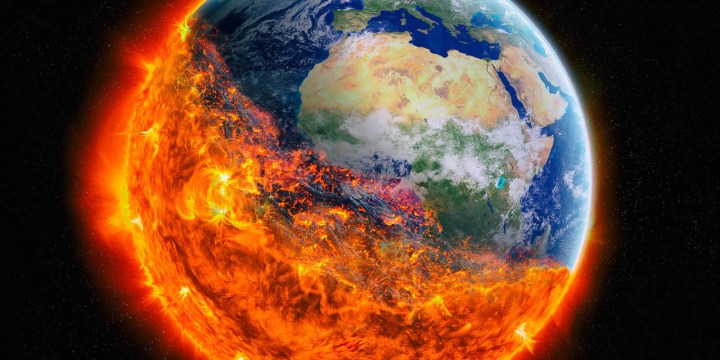CLIMATE CRISIS
Nasa warns of multiple devastating impacts beyond 2°C of global warming, which may be breached in the 2040s

A recent study led by Nasa scientists has found that the impacts of climate change will compound at 2°C of global warming. The planet may breach that critical threshold in the 2040s.
A study by Nasa scientists, What Does Global Land Climate Look Like at 2°C Warming?, published in the journal Earth’s Future, analysed the risks of climate change at different levels of warming. The researchers found that at 2°C of warming, the risks of extreme weather events such as heatwaves, droughts, floods and wildfires will increase significantly.
They further found that 2°C of climate change will have a significant impact on agriculture, leading to crop failures and food shortages. It will also exacerbate health problems such as heat stress and respiratory diseases.
The authors of the study worked with a specially processed set of climate predictions. The predictions were originally generated by 35 of the world’s leading climate models — specifically, contributors to the Coupled Model Intercomparison Project (CMIP).
Higher heat stress
“CMIP provides climate projections that help the Intergovernmental Panel on Climate Change and other international and national climate groups understand historical, current and future climate changes,” Nasa noted.
Heat stress and fire weather — which considers temperature, rainfall, humidity, and wind — were the two climate indicators that were largely the focus of the researchers. According to Nasa, most of the world will experience higher heat stress, while countries closer to the equator will suffer from a greater number of days considered extreme.
Ramakrishna Nemani, a senior scientist at the Bay Area Environmental Research Institute and a co-author of the study, said, “The escalating impacts of all the climate extremes studied could cause significant damage to communities and economies, from fires, floods, landslides and crop failures that may result.”
The study says, “Many of the future changes are expected to exacerbate climate impacts including heat stress and fire danger. Our analysis shows geographic patterns of policy-relevant climatic changes, as parts of the globe will experience significant climate impacts even if the goal to keep warming below 2°C goal is achieved.”
In the plain language summary, the study notes: “In the 2040s, our analysis shows significant changes in six key climate variables (mean air temperature, precipitation, relative humidity, downwelling shortwave and longwave radiation, and wind speed) but with geographically varying magnitude and direction of changes.
“These changes collectively result in increasing risks of heat stress and fire which already manifest as life-threatening impacts resulting from climate change. Many of the projected changes are expected to exacerbate climate impacts, and our fine-scale spatial analysis reveals that parts of the globe (e.g., countries in lower latitudes) will experience significant climate impacts even if pledges to limit warming to less than 2°C are achieved.”
Read more in Daily Maverick: Hot, hot July 2023 set to be hottest month in recorded history — almost certainly caused by humans burning fossil fuels
Dr Gina Ziervogel, an associate professor in the Department of Environmental and Geographical Science and director of the African Climate and Development Initiative at the University of Cape Town, shared her thoughts on the study and what its findings mean for South Africa.
“I think this paper is really important because it has worked with CMIP and the global models to try and understand what future climate impacts might look like and so they show very clearly that we are expecting a two-degree increase by 2040, which is relatively soon in the sense that we need to put policies and plans in place now to try and reduce both the scale of this — so try and reduce carbon emissions so we don’t get to two degrees — but if we do not do that we can see what the impact of climate change might be like if we do get to two degrees.
South Africa is a big contributor to greenhouse gas emissions, so we really have to make sure policymakers are taking this seriously.
“It is concerning because there will be significant increases in temperature and as the authors point out in the paper, these temperature increases come with an increase in the likelihood of fire and heat stress; both are of extreme concern globally and in southern Africa.
“I think in South Africa the increasing temperatures are particularly concerning. We have a lot of reliance on natural resources and agriculture, we are a drought-prone country and we are likely to feel the impacts of this even more with increased temperatures and we know that fire can place a large burden on society and have devastating impacts.”
What needs to be done?
Ziervogel explained that it is critical that there be a holistic and integrated approach to mitigating planet-warming emissions and readying the country to adapt to a changing climate.
“Actions that need to be taken really point to how important it is to take mitigation seriously. South Africa is a big contributor to greenhouse gas emissions, so we really have to make sure policymakers are taking this seriously and that we are playing our part in reducing emissions.”
She added that her work deals with adaptation and explained, “In order to have adaptation that is effective to actually implement responses that reduce the impacts of climate change, we need to improve how we do things. We need to have improved coordination both within government and between government, the private sector and civil society.
“One of the things we’ve learnt over the last 10 years is that planning for adaptation needs to be done in a holistic way that understands the system. We are starting to realise that there are so many interconnections between different sectors that we have to take a more holistic approach.
“Another part that is critical is closer engagement between climate scientists, policymakers, planners and practitioners. We have examples of where there has been good interaction between these groups, but we need to come together more holistically.”
But policies that are mindful of the climate imperative needn’t exclude other developmental imperatives and practical realities, she explained.
“Policymakers need to understand the urgency of this and, for me, what’s important is that a climate-informed response does not need to be seen as something that compromises other development priorities. So, in fact, most of the action that is urgent is likely to improve the quality of life currently as well as in the future.
“For example, we think of cities and the increasing temperatures we are going to expect. Cities do often bear the brunt of that because of the heat island effect, where temperatures are higher in urban areas, but if we think of how to build in cities to manage heat we will have cooler buildings and there are lots of ways to do this — passive heating, lighter areas, airflow, etcetera — and that doesn’t have to take much more resources, it just requires a shift in our planning and thinking.
“So it’s a shift in how we think about things, it’s a shift in how we go about things, bringing different groups together.” DM


















Right there as you read about the 35 models in CMIP you can dismiss the whole article. Those models use RCP8.5 and even the IPCC has now acknowledged that this scenario is completely unlikely.
Thus all projections are completely invalid
When did IPCC dismiss RCP8.5 as extremely unlikely? What is the IPCC consensus on climate change causes?
That’s a radical conclusion, for no good reason (which makes me wonder which axe you’re grinding). As far as I know, CMIP uses all four RCPs, and the other three are considered well inside likely (and RCP8.5 was in any case extremal by design).
There’s no reason to dismiss any of this article, and the projections *are* valid.
Blah blah blah, such a load of nonsense
You are probably employed by a company that produces fossil fuels given your level of understanding and appreciation. The flat earth society would be proud to have you as one of their honorary members
Nope, I’m just not dumb enough to fall for he biggest con in history